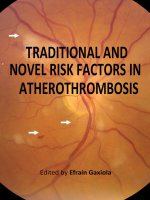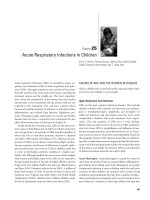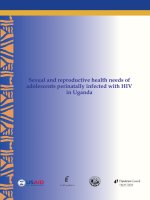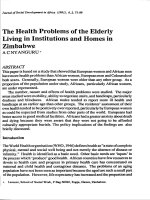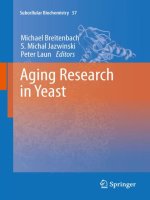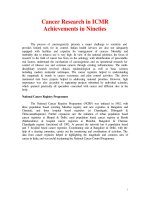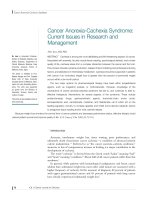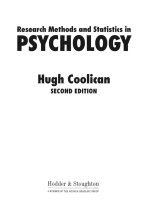DRUG DISCOVERY RESEARCH IN PHARMACOGNOSY ppt
Bạn đang xem bản rút gọn của tài liệu. Xem và tải ngay bản đầy đủ của tài liệu tại đây (9.71 MB, 254 trang )
DRUG DISCOVERY
RESEARCH IN
PHARMACOGNOSY
Edited by Omboon Vallisuta
and Suleiman M. Olimat
Drug Discovery Research in Pharmacognosy
Edited by Omboon Vallisuta and Suleiman M. Olimat
Published by InTech
Janeza Trdine 9, 51000 Rijeka, Croatia
Copyright © 2012 InTech
All chapters are Open Access distributed under the Creative Commons Attribution 3.0
license, which allows users to download, copy and build upon published articles even for
commercial purposes, as long as the author and publisher are properly credited, which
ensures maximum dissemination and a wider impact of our publications. After this work
has been published by InTech, authors have the right to republish it, in whole or part, in
any publication of which they are the author, and to make other personal use of the
work. Any republication, referencing or personal use of the work must explicitly identify
the original source.
As for readers, this license allows users to download, copy and build upon published
chapters even for commercial purposes, as long as the author and publisher are properly
credited, which ensures maximum dissemination and a wider impact of our publications.
Notice
Statements and opinions expressed in the chapters are these of the individual contributors
and not necessarily those of the editors or publisher. No responsibility is accepted for the
accuracy of information contained in the published chapters. The publisher assumes no
responsibility for any damage or injury to persons or property arising out of the use of any
materials, instructions, methods or ideas contained in the book.
Publishing Process Manager Sandra Bakic
Technical Editor Teodora Smiljanic
Cover Designer InTech Design Team
First published March, 2012
Printed in Croatia
A free online edition of this book is available at www.intechopen.com
Additional hard copies can be obtained from
Drug Discovery Research in Pharmacognosy,
Edited by Omboon Vallisuta and Suleiman M. Olimat
p. cm.
ISBN 978-953-51-0213-7
Contents
Preface IX
Chapter 1 Ayurveda the Ancient
Science of Healing: An Insight 1
Manoj Goyal, D. Sasmal and B.P. Nagori
Chapter 2 Developments in Phytochemistry 11
Moronkola Dorcas Olufunke
Chapter 3 Analytical Evaluation of Herbal Drugs 23
Anjoo Kamboj
Chapter 4 Standardized Cannabis and Pain Management 61
A. Paul Hornby
Chapter 5 The Research of Lygodium 77
Zhang Guo-Gang, He Ying-Cui,
Liu Hong-Xia, Zhu Lin-Xia and Chen Li-Juan
Chapter 6 Natural Alkamides:
Pharmacology, Chemistry and Distribution 107
María Yolanda Rios
Chapter 7 A Comparison Between Lignans from Creosote
Bush and Flaxseed and Their Potential
to Inhibit Cytochrome P450 Enzyme Activity 145
Jennifer Billinsky, Katherine Maloney, Ed Krol and Jane Alcorn
Chapter 8 Potential Applications of
Euphorbia hirta in Pharmacology 165
Mei Fen Shih and Jong Yuh Cherng
Chapter 9 Medicinal and Edible Plants
as Cancer Preventive Agents 181
Ken Yasukawa
VI Contents
Chapter 10 Induction and Activation of Plant
Secondary Metabolism by External Stimuli 209
Fumiya Kurosaki
Chapter 11 The Metabolites of Food Microorganisms 227
Hirofumi Takigawa and Yusuke Shibuya
Preface
Pharmacognosy is an interdisciplinary study, drawing from a broad spectrum of
biological and even socio-scientific subjects. Even though most of the pharmacognostic
studies are focused on medicinal plants / herbal medicines, other organisms are
regarded pharmacognostically interesting. Particularly this is true for different types
of microbes, i.e. bacteria and fungi. More recently, many marine organisms have
become targets of pharmacognostic studies.
The subject deals with natural drugs from plants, animals or minerals and even
microorganisms. Therefore the scope of research is extremely wide ranging from
traditional medicine to modern biotechnology with phytochemistry and analytical
chemistry, which play an important part in the quality assurance of the raw material
and their finished products.
This book provides a full picture of research in the area of pharmacognosy with the
goal of drug discovery from natural products based on the traditional knowledge or
practices. Several plants that have been used as food show their potential as
chemopreventive agents and the claims of many medicinal plants used in traditional
medicine are now supported by scientific studies.
Drug Discovery Research in Pharmacognosy is a promising road map which will help
us find medicine for all!
Dr. Omboon Vallisuta
Department of Pharmacognosy, Faculty of Pharmacy,
Mahidol University, Bangkok,
Thailand
Dr. Suleiman M. Olimat
Department of Pharmaceutical Sciences, Faculty of Pharmacy,
University of Jordan, Amman,
Jordan
1
Ayurveda the Ancient
Science of Healing: An Insight
Manoj Goyal
1
, D. Sasmal
2
and B.P. Nagori
1
1
Lachoo Memorial College of Science and Technology,
Pharmacy Wing, Jodhpur, Rajasthan,
2
Department of Pharmaceutical Sciences, BIT Mesra, Ranchi, Jharkhand,
India
1. Introduction
The term Ayurveda, a Sanskrit word, translates into knowledge (Veda) of life (Ayur); Veda
also means science. After being transmitted orally for thousands of years, the ancient
Ayurvedic texts finally were written and preserved in Sanskrit (an ancient Indian language).
Founded on the collective wisdom of ancient Hindu saints and healers, Ayurveda grew into
a medicinal science. Ancient Ayurveda was meant essentially to promote health, however,
rather than fight disease. The Ayurvedic text, an offspring of the Atharvaveda, appeared
sometime in 1500 to 1000 BC and described two schools of learning physicians Atreya and
surgeons Dhanvantari. Charak Samhita (1000 BC) and Sushrut Samhita (100 AD) are the main
classics. Ayurveda materia medica gives detailed descriptions of over 1500 herbs and 10,000
formulations. Madhav Nidan (800 AD) a diagnostic classic provides over 5000 signs and
symptoms. There are eight branches of study in Ayurveda: Kaya Chikitsa (General Medicine),
Kaumara Bhruthya (Paediatrics), Bhutha Vidhya (Psychiatry), Salakya (ENT and
Ophthalmology and dentistry), Shalya (Surgery), Agada Tantra (Toxicology), Rasayana
(Rejuvenation Therapy) and Vajeekarana (sexual vitality) (Lad, 1995; Agnihotri, 2000; Chopra
and Doiphode, 2002; Mukherjee and Wahile, 2006; WHO, 2010; Balasubramani et al., 2011).
1.1 Core concept of ayurveda
In Ayurveda, health is defined as the state where physical body, senses, and psyche are in
original or natural state with respect to body and function. Ayurveda believes that both
world and human body are made up of five elements earth, water, fire, air, and space (ether)
called as Panch-mahabhuta. While we are a composite of these five primary elements, certain
elements are seen to have an ability to combine to create various physiological functions
(Mishra, 2004).
The human body according to Ayurveda is made up of somatic dosas (Vata, pitta and kapha)
and psychic components (satogun, rajogun and tamogun), body tissues or dhatus {Rasa
(plasma), Rakta (blood), Mansa (muscular tissue), Meda (adipose tissue), Asthi (Bone), Majja
(marrow and myeloid tissue) and Shukra (Sperm/Ovum)} and waste products or
malas {
mutra (urine), purisha (faeces) and sveda (sweat)} (Vasant, 2005).
Drug Discovery Research in Pharmacognosy
2
Vata: Ether and air combine to form what is known in Ayurveda as the Vata dosha, vata
governs the principle of movement and therefore can be seen as the force which directs
nerve impulses, circulation, respiration, and elimination. Vata is dry, cold and light and
correspond to the element air.
Pitta: Fire and water are the elements that combine to form the Pitta dosha. The Pitta dosha is
the process of transformation or metabolism. The transformation of foods into nutrients that
our bodies can assimilate is an example of a pitta function. Pitta is also responsible for
metabolism in the organ and tissue systems as well as cellular metabolism. Pitta is oily, hot
and light and correspond to the element fire.
Kapha: Water and earth elements combine to form the Kapha dosha. Kapha is responsible for
growth, adding structure unit by unit. Another function of the Kapha dosha is to offer
protection. Cerebro-spinal fluid protects the brain and spinal column and is a type of Kapha
found in the body. Also, the mucousal lining of the stomach is another example of the Kapha
dosha protecting the tissues. Kapha is wet, cold and heavy and corresponds to the element
water (Sebastian, 2006; Walter, 2006).
These three dosas coexist in a predetermined proportion and function in a complementary
manner to overall function of the total organism in spite of their opposite properties and
functions. The existence of the dosas can be understood at both the macromolecular and
micromolecular levels. A balance in the activity of these dosas is necessary for health.
2. Pathogenesis of disease
According to Ayurveda, there are three main causes of disease, namely asatmyendriyartha
samyoga (indiscriminate use of senses and their objects), prajna-aparadha (error of intellect
resulting in a loss of discrimination between wholesome and unwholesome with subsequent
indulgence in unwholesome diets and behaviour) and kala- parinama (seasonal variation,
cosmic effects and the effects of time) (Frank, 2001).
Pancha lakshana nidana, the five components of the pathology of a disease, assists in
diagnosis. They are nidana (causative factors), purvarupa (prodromal symptoms/ incubatory
symptoms), rupa (signs and symptoms), samprapti (pathogenesis) and upashaya (diagnostic
tests).
Samprapti: The concept of six stages of pathogenesis is vital for an understanding of the
pathological states of the doshas that result in disease. First stage is called as Sanchaya
(accumulation), due to weak digestive power and accumulation of ama (toxins) causes
imbalance in doshas. The second stage is Prokapa (aggravation), the accumulated, stagnant
doshas are excited by factors as ahara, vihara and seasons. Stage three called as prasara
(overflowing/ spread), in this stage, the toxins accumulated start overflowing. Generally, up
to this stage the damage is entirely reversible and restoration of doshas balance can be
achieved with proper measures.
Sthanasamsraya (localization/ agumentation) is stage four characterized by migration of
overflowing toxins in localized weak or defective dhatus thereby leading to malfunction and
structural damage.
Ayurveda the Ancient Science of Healing: An Insight
3
Vyakti (manifestation) and bheda (chronic complications) are fifth and sixth stages of
pathogenesis, characterized by appearance of symptoms of diseases and chronic
manifestation respectively.
3. Diagnosis of disease
The starting place of a successful treatment is a clear diagnosis. ayurvedic diagnostic methods
are founded on the three methods of knowing (pramana). These are direct pratyaksa
(perception), aptopadesa, sabda (textual authority) and anumana (inference). The most clinically
useful is direct perception and it includes Susruta’s threefold methods of diagnosis trividha
pariksa that includes sparsana (palpation), darsana (looking), and prasana (questioning). Caraka
has mentioned that direct perception (pratyaksa) includes using the five senses meaning that
listening, feeling, looking, smelling and tasting. Later on it became astasthana pariksa which
includes examination of nadi (pulse), mutra (urine), malam (faeces), jihva (tongue), shabda
(voice), sparsha (skin or touch), drika (sight or eyes) and akriti (appearances, face, overall
appearance) (Tirtha, 1998; Mishra, 2004; Vasant, 2005; Sebastian, 2006).
4. Dravyaguna vigyan (ayurvedic pharmacology)
In Ayurveda, substances of natural origin, including whole plants or their parts, animal
parts and minerals, are used as medicines, either alone or in combination. In addition,
various other measures are used in an attempt to maintain health in a healthy person and
alleviate disorders of the body and mind. These substances act on the principles of samanya
(homologous) and visesha (antagonistic) action.
Substances possessing homologous properties and actions increase the relevant elemental
properties or constituents of the body while those having antagonistic properties or actions
decrease those properties or constituents. In cases of disease or imbalance of dosha, dhatu and
mala, the rational use of naturally available substances aims to restore normality.
The composition of elements in medicines and the diet is studied in terms of various
properties, referred to as rasa, guna, virya, vipaka and prabhava. The effect and action of the
medicines or diet depends on these properties.
Rasa (taste): Taste of medicine as perceived by tongue.
There are six different tastes, each with a predominance of two elements and showing the
characteristics of these elements. Administration of a medicine featuring a particular rasa
enhances that property in the body and decreases its opposite. The six tastes are madhura
(sweet), amla (sour), lavana (salty), katu (pungent), tikta (bitter) and kashaya (astringent).
Tastes provide varying degrees of nourishing strength. Sweet taste is the most nourishing,
and as each taste becomes less nourishing, it becomes more bitter, until it is astringent and
the least nourishing.
Guna (attributes): Not be measurable but inferred through their pharmacological action,
guna is property of a medicine detected by sense organs other than the tongue. It appears
that guna are intimately related to rasa it is a fact that both are separate principles co-existent
in the dravya (substance). They are 20 in number and represent the characteristics of the
elements. There are 10 pairs of contrasting characteristics – guru (heavy)/ laghu (light),
Drug Discovery Research in Pharmacognosy
4
manda (dull)/ tikshna (sharp), sita (cold)/ ushna (hot), snigdha (unctuous)/ ruksha (non-
unctuous), slakshna (smooth)/ khara (rough), sthira (immobile)/ sara (mobile), mridu (soft)/
kathina (hard), visada (clear)/ picchila (slimy), sandra (solid)/ drava (fluid), sthula (bulky)/
sukshma (fine).
Virya: Denotes the potency of the medicine. There are eight virya namely mridu, teekshana,
guru, laghu, snigdha, ruksha, ushna and sita, representing the active gunas. These can be put
into two broad categories – sita (cooling) and ushna (heating).
Vipaka (postdigestive effect): It is the postdigestive effect of rasas, the same elements
predominate as in the original rasas, with the corresponding action. There are three vipakas.
A sweet taste becomes madhura vipaka; sour and salty tastes become amla vipaka and
pungent, bitter and astringent tastes become katu vipaka.
Prabhava (pharmacological action): Prabhava has been defined as the special property of a
substance which produces actions different from and contrary to those ascribed to rasa,
guna, virya and vipaka. The chemical composition which largely determines the secondary
qualities of a dravya (substance) such as rasa, guna, virya and vipaka does not determine a
chemical compound. The rasa, guna, virya and vipaka
of Danti (Baliospermum montanum.) and
Chitraka (Plumbago zeylanica) being apparently identical, the former produces purgation,
whereas the latter does not produce this action and the specific purgative action of Danti is
attributed to its prabhava (inexplicable nature) (Paranjpe, 2001; Nishteswar, 2007).
5. Ayurvedic chikitsa (therapeutics)
Ayurveda says that healthy of an individual is preserved due to equilibrium of the doshas. In
diseased people, treatment eliminates the disequilibrium between the doshas, and the body
is restored to normality. The body has its own intelligence to create balance, ayurvedic
treatments helps in that process.
Diseases are treated by nidana parivarjana, (avoidance of causative and provocative factors),
shodhana and panchakarma (purifying therapies), shamana (palliative therapies) and rasayana
(rejuvenation) and vajikarana (aphrodisiac).
5.1 Nidana parivarjana (preventive measures)
The preventive measures or nidana parivarjana includes swastha varta (personal hygiene),
dinacharya (daily routine), ritucharya (seasonal corrections) and sadachara (appropriate
behaviour).
5.2 Shodhana karma (purifying therapy)
Formation of toxins reduces that natural capacity of body for healing and rejuvenating. The
shodhan karma such as panchakarma enables the body to release excess doshas and ama
(toxins) from cells.
Panchakarma: Is the method of shodhana/detoxification or elimination of toxins from the body.
It is divided in three stages poorvakarma (preparatory procedures) pradhan karma (main
therapy) and uttara karma (post therapy care).
Ayurveda the Ancient Science of Healing: An Insight
5
Poorvakarma (preparatory procedures) includes snehana (oelation therapy) and swedana
(fomentation therapy).
Snehana or oelation therapy involves saturation of the body with herbal & medicated oil via
external & internal oelation to make body soft and disintegrate the doshas. Shirodhara is the
most commonly employed pre-procedure; it means the dripping of oil like a thread (dhara)
on the head (shiro). This treatment drips warm oil in a steady stream on the forehead,
particularly on the brow and in the region between the eyes. It is often added to the
panchakarma regimen because it pacifies vata and calms the central system. It cleans both the
mind and the senses which allow the body's natural healing mechanisms to release stress
from the nervous systems.
Swedana/ fomentation or sweating is necessarily follows oleation, Swedana is induced by heat
from different sources it brings sweat on the skin through hair follicles by opening the pores
of the skin. Fomentation increases the agni (biofire) and the fatty tissue gets mobilised. It
also throws out ama (toxins/waste) through the skin and helps in liquefying aggravated
doshas. Swedana has two main types, agni sweda wherein heat is applied directly as steam and
anagni sweda where no external heat source is necessary e.g exercises, fighting, walking,
lifting heavy loads, exposure to sunlight, putting heavy blankets over the body etc.
Pradhan Karma is consists of the five essential purificatory therapies namely vamana
(vomiting), virechan (purgation), anuvasana and niraha (medicinal enema), nasya (nasal
insufflation, administration) and raktamocana (blood cleansing).
Vamana (emesis): It is therapeutic emesis; done regularly to cleanse the stomach and remove
áma (toxins) and mucus from chest. It is used for relieving recent fever, diarrhea, pulmonary
infections, skin diseases, diabetes mellitus, goiter, and obesity. Vamana is induced using
herbs such as vacha (Acorus calamus) and licorice (Glycyrrhiza glabra).
Virechan (purgation): This is the simplest method of panchakarma and has most easily
observed effects. It is an excellent method to heal various conditions, including abdominal
tumors, hemorrhoids, smallpox, patches of skin discoloration on the face, jaundice, chronic
fevers and enlarged abdomen. Strong cathartic and laxative herbs such as jaiphal (Croton
tiglium), aragwad (Cassia fistula), or castor oil (Ricinus communis) are used for induction of
purgation.
Anuvasana and niraha (enemas): For patients emaciated by fever, neither vamana nor virechan
is useful. The mala (digestive waste and toxin) of patients is removed by nirha by using
decoction enemas. To prevent aggravation of vata, an oil enema (anuvasana basti).
Nasya (Nasal cleansing therapy): Nasya means nasal administration of medicated powders
or liquids. It is a procedure in which medicament administered through the nostrils in order
to purify the head and neck region. Nasya is useful in relieving stiffness in the head, neck
arteries, throat, and jaw obstructions, nasya is useful in disorders of the neck, shoulders,
ears, nose, mouth, head, cranium, and scapula.
Raktamokshana (Blood-letting): The small amount of blood is removed intravenously or by
leeches, the toxins are removed quickly from systemic circulation. It is useful in blood
toxaemia, hypertension and skin disorders. Raktamokshana is contraindicated in anemia and
pregnancy.
Drug Discovery Research in Pharmacognosy
6
Uttara karma: It is important to resume or establish a diet and lifestyle that is harmonious
with one’s constitution. If a person returns to old, bad habits, they may worsen their
condition by suppressing the renewed healing energies. The toxins may then directly enter
cleansed tissues and go deeper than before, causing severe diseases. During convalescence,
persons avoid loud talking, bumpy rides, long walks, excessive sitting, and eating, if
experiencing indigestion. To avoid aggravating the humors, persons also avoid eating
unwholesome food, day naps, and sexual relations (Ojha et al., 1978; Joshi, 2005).
5.3 Shamana karma (alleviation therapy)
According to Ayurveda, shamana is the balancing and pacification of bodily doshas, shamana
is used when panchakarma is inappropriate due to the poor strength of the patient. Shamana
consists of dipana, pacana, vrata or ksunnigraha, trsna or ernnigraha Vyayama, Atapasevana
and Marutha.
Dipana (enkindling): Dipana means enkindling the digestive fire by using warm meals, hot
water, eating a small piece of fresh ginger mixed with lime juice and salt before a meal,
having a short walk before meals to stimulate the agni. dipana is absolutely necessary in
kapha and vata disorders, where the person has low gastric fire.
Pacana (digestion): Pacana means digesting of ama (toxins) and undigested residues, pacana
uses many of the same herbs as dipana but instead of taking them before a meal they are
taken afterwards and usually at double the dose. These hot herbs literally burn the ama. The
indication for using pacana is when there is hunger but not enough ‘fuel’ to fan the digestive
flames. These spices are the fuel. Of course, when there are already inflammatory
conditions, such as ulcers, caution must be taken.
Vrata or ksunnigraha (fasting): Ksunnigraha means to ‘hold onto your hunger. Fasting inspire
a healthy hunger; a true need for food taken in the balanced quantity. Fasting or monodiet
are suggested according to dosha. Vata people can do a short fast on hot liquid soups, pitta
constitution can do a liquid fast on fruit juices such as grape or pomegranate and kapha
types can do a literal fast; although this is a great struggle for them as it challenges their
tendency to hold onto things.
Trsna or Ernnigraha (observing thirst): Not drinking water or fasting from water is known as
trsna or ernnigraha
. Trsna is beneficial in water diseases such as oedema, diabetes or kidney
problems. It reduces the stress on the water channels in the body (ambuvahasrotas).
Vyayama (exercise and yoga): Ayurveda says exercise has such a quality that it strengthen
the dhatus, increase agni, improve circulation, accelerates the heart rate, enhances the
combustion of calories and also stimulates metabolism, regulates body temperature and
maintains body weight. Exercise makes your senses alert and attentive and your mind
becomes very sharp and develops keen perception. These qualities of exercise are very
important, but again, exercise varies from person to person, Vata types should do more
relaxing and gentle exercise. Kapha people can do more vigorous exercise and pitta should
exercise regularly but moderate.
Atapa seva (sunbathing): The sun is the source of heat and light. Atapaseva is very useful for
lightening the body, increasing the agni and treating bhrajaka pitta. Many conditions are
Ayurveda the Ancient Science of Healing: An Insight
7
improved by sitting in the sun; certain types of eczema, psoriasis, arthritis, depression and
water retention to name a few. Lying in the sun and meditating upon the solar plexus, is a
wonderful shaman for kapha and vata. It improves circulation, the absorption of vitamin D,
and strengthens the bones.
Maruta/ Marutaseva (wind-bathing): Marutaseva is specifically relates to the yogic practice of
pranayama and of becoming inherently tuned into deep slow breathing using a deep
inhalation and long exhalation. It is about imbibing prana; the life force surfs on the breath
and flows deep into our tissues. Specific problems such as asthma, bronchitis and
emphysema greatly benefit from this practice. Also people with a tendency to experience
excessive anxiety and fear in their lives benefit from watching the breath flow in and out of
themselves.
5.4 Rasayana (rejuvenative) and vajikarana (aphrodisiac)
Rejuvenation involves brmhana (building therapy) using tonic herbs such as ashwagandha
(Withania somnifera), shatavari (Asparagus racemosus) and bala (Sida cordifolia) to nourish all
the tissues, build the strength, enhance ojas and strengthen immunity. It also involves eating
building foods like nuts, ghee and dairy products.
Rasayana (tonic): In Ayurveda tonics are sweet, heavy and oily in quality. The sweet flavour
increases the quantity and quality of the tissues as it is anabolic. So many of the modern
wonder herbs that boost immunity are full of immune-enhancing saponins and
polysaccharides. The sweet flavour is tonifying and rejuvenating, but it must be of a high
quality and fully digested to benefit the whole system. Popular ayurvedic tonics are
chayawanaprash, ghee and walnuts (Juglans regia).
Vajıkarana (aphrodisiacs): This refers to herbs that nourish the reproductive organs, increase
fertility, promote libido as well as prevent ageing. Herbs such as kapikacchu (Mucuna
pruriens), ashwagandha (Withania somnifera) and amalaki (Emblica officinalis) are renowned
reproductive tonics as well as being antioxidants (Frawley, 2000; Panda 2000; Acharya, 2005;
Sudarshan, 2005; McIntyre, (2005); Murthy and Pandey, 2008).
6. Discussion
Ayurveda has been practiced in India for over 5000 years and is recognized as a complete
medical system comparable with allopathic medicine by the government of India. In India,
Ayurveda has a complete infrastructure, medical colleges, hospitals integrated with
allopathic medicine, research institutes, and scientific journals devoted to Ayurveda. In
addition, India’s Ayurvedic pharmaceutical industry is governed by the same food and
drug laws that regulate conventional drugs. Research in pharmacology, biochemistry,
phytochemistry, and clinical trials of Ayurvedic therapies currently constitutes a substantial
portion of the total research conducted in government institutes and medical colleges in
India (Mishra, 2004).
Ayurveda has the potential to develop into a global health-care system. The concepts of
proper lifestyles, personal hygiene, daily routine, seasonal corrections, diet, yoga and herbal
therapy can be adopted with suitable modification to different countries in different parts of
Drug Discovery Research in Pharmacognosy
8
the globe after giving due consideration to the culture, life style and available medicinal
plant resources of the countries.
Name of Category Meaning in
English
Name of Category Meaning in English
Angamarda-
prasamana
Pain relieving
Purisa-virajaniya
Faecal depigmenter
Anuvasanopaga
Unctuous enemata
Sandhaniya
Healing
Arsoghna
Anti-
haemorrhoidal
Sanjna-sthapana
Energising
Asthapanopaga
Corrective
enemata
Sirovirecanopaga
Errhines
Balya
Tonic
Sita-prasamana
Calefacient
Bhedaniya
Laxative
Snehopaga
Moisturising
Brmhaniya
Bulk-promoting
Sonita-sthapana
Haemostatic
Chardi-nigrahana
Anti-emetic
Srama-hara
Energy
compensator
Daha-prasamana
Refrigerent
Stanya-janana
Galactogogue
Dipaniya
Appetite stimulant
Stanya-sodhana
Galacto-depurant
Hikka-nigrahana
Anti-hiccough
Sukra-janana
Semen promoting
Hrdya
Cordial
Sukra-sodhana
Semen depurant
Jivaniya
Vitalising
Sula-prasamana
Intestinal
antispasmodic
Jwara-hara
Anti-pyretic
Swasa-hara
Anti-dyspneic
Kandughna
Anti-pruritic
Swayathu-hara
Anti-phlogistic
Kanthya
Beneficial for
throat
Swedopaga
Diaphoretic
Kasa-hara
Antitussive
Trptighna
Thirst-quenching
Krimighna
Anthelmintic
Trsna-nigrahana
Anti-dyspepsic
Kusthaghna
Anti-dermatosis
Udara-prasamana
Anti-allergic
Lekhaniya
Emaciating
Vamanopaga
Emetic
Mutra-sangrahaniya
Anti-diuretic
Varnya
Complexion-
promoting
Mutra-virajaniya
Urinary
depigmentor
Vayah-sthapana
Rejuvenating
Mutra-virecaniya
Diuretic
Vedana-sthapana
Analgesic
Praja-sthapana
Anti-abortificient
Virecanopaga
Purgative
Purisa–samgrahaniya
Intestinal
astringent
Visaghna
Anti-poison
Table 1. Pharmacological categories of various drugs used in Ayurveda.
Ayurveda the Ancient Science of Healing: An Insight
9
7. Acknowledgment
Authors are grateful to all experts of Ayurveda whose work referred in this article.
8. References
Acharya, V., Rao. (2005). Ayurvedic Treatment for Common Diseases. New Delhi: Diamond
Pocket Book.
Agnihotri, M.S., (2000). Ayurved (ancient Indian system of medicine) and modern molecular
medicine. The Journal of the Association of Physicians of India. 48: 366-367.
Balasubramani, S.P., Venkatasubramanian, P., Kukkupuni, S.K., Patwardhan, B., (2011).
Plant-Based Rasayana Drugs from Ayurveda. Chinese Journal of Integrative
Medicine. 17: 88-94.
Chopra, A., Doiphode, V.V., (2002). Ayurvedic medicine: Core concept, therapeutic
principles, and current relevance. Medical Clinics of North America. 86: 75-89.
Frank, J., N. (2001). An elementary textbook of Ayurveda: medicine with a six thousand year
old tradition. Madison, CT: Psychosocial Press.
Frawley, D. (2000). Yoga and Ayurveda: self-healing and self-realization. Delhi: Motilal
Banarasidas Publication.
Joshi, S., V. (2005). Ayurveda and Panchakarma: The Science of Healing and Rejuvenation,
Motilal Banarasidas Publication, Delhi.
Lad, V., (1995). An introduction to Ayurveda. Alternative Therapies in Health and Medicine.
1: 57-63.
McIntyre, A. (2005). Herbal Treatment of Children: Western and Ayurvedic Perspectives.
London: Elsevier Butterworth-Heinemann.
Mishra, L. C. (2004). Scientific basis for Ayurvedic therapies. USA: CRC Press.
Mukherjee, P.K., Wahile, A., (2006). Integrated approaches towards drug development from
Ayurveda and other Indian system of medicines. Journal of Ethnopharmacology.
103: 25-35.
Murthy, N., A., Pandey, D., P. (2008). Ayurvedic cure for common diseases. New delhi:
Orient Paperbacks.
Nishteswar, K. (2007) Basic Concepts of Ayurvedic Pharmacology Varanasi: Chowkamba
Sanskrit Series.
Ojha, D., Kumar, A., Kumar, A. (1978). Panchakarma Therapy in Ayurveda. Varanasi:
Chaukhamba Amarabharati Prakashan.
Panda, H. (2000). Handbook On Herbal Medicines. Delhi: Asia Pacific Business Press.
Paranjpe, P. (2001). Indian medicinal plants: forgotten healers : a guide to ayurvedic herbal
medicine with identity, habitat, botany, photochemistry, ayurvedic properties,
formulations & clinical usage. Varanasi: Chaukhamba Sanskrit Pratishthan.
Sebastian, Pole. (2006). Ayurvedic medicine: the principles of traditional practice. London:
Churchill Livingstone Elsevier.
Sudarshan, S., R. (2005). Encyclopaedia of Indian Medicine: Diseases and Their Cures.
Mumbai: Popular Prakashan.
Tirtha, S., S. (1998). The Ayurveda encyclopedia: natural secrets to healing, prevention &
longevity. Bayville, NY: Ayurveda Holistic Center Press.
Drug Discovery Research in Pharmacognosy
10
Vasant, Lad. (2005). Ayurveda: the science of self-healing : a practical guide. Delhi: Motilal
Banarasidas Publication.
Walter, Kacera. (2006). Ayurvedic Tongue Diagnosis. USA: Lotus Press.
World Health Organization. (2010) Benchmarks for training in Ayurveda. Geneva: WHO.
Available at:
www.who.int/entity/medicines/ /BenchmarksforTraininginAyurveda.pdf
Accessed, 15 April 2011.
2
Developments in Phytochemistry
Moronkola Dorcas Olufunke
Department of Chemistry,
University of Ibadan,
Nigeria
1. Introduction
Carbohydrates, proteins, fats and oils are utilized as food by man and animals. Other
chemical compounds in plants apart from these listed above are phytochemical. Such
compounds usually exert peculiar, unique and specific active physiological effects
responsible for their therapeutic and pharmacological functions. Activities of such naturally
occurring compounds are generally responsible for changes, which are utilized to satisfy
man’s desires. Phytochemical studies afford revelation and understanding of
phytoconstituents, as much as possible conserving their bioactivities, and are on how to
standardize them; compared with the crude herbal methods that are not easily
standardized. These complex substances of diverse nature occur mostly in plant based
foods; they are in very small amounts in grams or mg or μg/Kg of samples. They do not add
to body calorie and are numerous in types. These phytochemical are applied mostly for
preventive and healing purposes. About 25% of prescribed drugs are obtained from
phytochemical in higher plants. Plants are safe means of obtaining drugs. About 250,000
higher plants have promising phytochemical, half of which are located in tropical forests;
60% of these have their biological activities established, while about 15% of them have their
phyto-compounds isolated and reported [Hamburger and Hostettman, 1991].
Studies and researches into medicinal constituents of plants, involve qualitative and
quantitative analyses. There is rationale behind each experimental work involving definite
steps and processes; having in mind properties of compounds analyzed in conjunction with
procedures utilized. Also our desired active metabolite to be isolated and studied as
interested lead compound, many times is in very complex mixtures of many unwanted and
undesired materials [known as contaminants], which have close properties to our desired
bioactive molecules.
2. General and specific techniques, procedures and methods in
phytochemical analyses, with highlight on recent developments in
phytochemistry
Most of the techniques and procedures in phytochemical analyses are cumbersome and
tasking, to have detailed understanding of phytoconstituents- [their activities, structures,
how to improve on them and standardize them]. If they are carefully followed one achieve
Drug Discovery Research in Pharmacognosy
12
the aim of isolations, characterizations and better establish bioactivities of active
metabolites.
Phytochemical methods mainly involve EXTRACTIONS, PURIFICATIONS and
ISOLATIONS of the active compounds in plants. Procedures are ways of carrying out the
methods and techniques. There are numerous methods some specific for interested
compounds one is looking for, duly modified to meet the required aim and focus of work.
There are daily modifications of techniques and procedures to suit individual purposes of
having the phytochemical compound(s) of interest. It is important to say that some natural
product may (to variable extent) or may not possess their pharmacological properties and
activities when in isolation compared to when among mixture of compounds (synergy) in
the natural setting in organism. Recently in genomics whole plant is analyzed which afford
easier and truthful analyses of contents in the whole plant as in their natural state.
It is important to first establish proper botanical taxonomic identifications and classification
of plant of study. Scientific names must be established, common and local names must be
sought. Right choice of study plants or part of plant to study may be from local or
traditional surveys i.e. ethno-medicine, ethno-pharmacology or ethno-botanical uses and
applications. Geographical location and environmental effects [time and period of plant
collection], must be considered also, which may be responsible for variations. Voucher
samples of plant of study may be filed in local and national herbaria for accurate
authentications. Usually plants are richer in active metabolites during their flowering and
fruiting stages [Mendonca-Filho, 2006].
Procedures involve first the analytical stages. Most times our desired active metabolite to be
isolated and studied as interested lead compound, is in very complex mixtures of many
unwanted and undesired materials [known as contaminants], more so they usually have
close properties to our desired bioactive molecules.
Preliminary tests and screenings on plant extracts are faster and easily done following
standard procedures and methods in manuals and literature. They detect the presence and
amount of basic phytoconstituents like terpenoids, alkaloids, flavonoids, saponin,
glycosides, steroids, tannins, phlobatannins and anthraquinones to mention few.
More common and familiar separation and isolation techniques in phytochemical studies
are distillation, crystallization, solvent extractions, continuous and liquid-liquid extractions,
partitioning using separatory funnels, and chromatography. For accuracy characterizations
follow side by side with the above techniques. Bioactivities can also be tested along the
above, such as antibacterial, antifungal and antioxidant. The followings are important to
consider during choice of procedures for separations and isolation of interested
biomolecules of interest:
• Availability of necessary materials, equipments and chemicals. Also economically
cheap methods.
• Ease and simplicity of procedures, and risk involved.
• Compatibility of interested solute with phases or solvents such as it distilling out [more
volatile phyto-compound], crystallizing and recrystallizing out from phases/ solvents
etc.
• Possibility of retrieval methods.
Developments in Phytochemistry
13
• Selectivity and sensitivity of chosen method(s) and equipments.
• Feasibility of chromatographying out our desired biomolecules from stationary phase
using appropriate and suitable solvent or mixture of solvents for elution. Also consider
factors like polarity, temperature, agitations etc.
• Provision of rapid online information on activities and structures of the phyto-
compound. [Specific methods can be better studied by consulting literature and
appropriate textbooks].
3. Isolation, characterization and identification of phytochemical in natural
products
Phytochemical are active metabolites that necessarily require extraction and isolation from
their natural sources with many unwanted materials. The phytochemical can come singly or
as a mixture of important substances to form active principle responsible for its activity
(synergy). When singly active, the processes of their separations are of great practical
advantages, which in many cases the isolated phytochemical have better and higher activity.
We will consider genomics and metabolomics later as more efficient methods of rapid
phytochemical screening and characterizations of plant extracts to study their chemical
constituents, using NMR-based metabolomics. It utilizes mathematical data; NMR is used
directly on extracts before commencing detailed work on plant. It makes it easy to
determine which plants are more promising to research into. A large number of variables
are collected, then choices on which are important are made, followed by selection
procedures.
3.1 More modern spectroscopy utilized in phytochemical studies
Once preliminary separations and detections have confirmed presence of active secondary
metabolites, their characterizations as they are separated follows. Chromatographic
techniques are utilized in separations and purifications to isolate bioactive constituents
based on polarity or other gradient factors. The isolated compound is characterized by
spectroscopic methods. The four basic types of spectroscopy are utilized in the
characterizations of purified natural product compounds. They are ultraviolet (UV), infra-
red (IR), mass-spectroscopy (MS) and nuclear magnetic resonance (NMR) techniques. MS is
an instrumental technique, while the other three utilizes different parts of the broad
electromagnetic radiation spectrum. UV spectroscopy discovered and utilized in the 1930s
gives detailed information on detecting presence of conjugation in molecules and the extents
of conjugation. By 1940s the infrared (IR) region of EMR was utilized to detect different
vibration frequencies of different chemical bonds present in the molecule. Combination of
these two types of spectroscopy [UV & IR] gave information about the functional groups
present in the molecule. MS was introduced a decade after by 1950s, involving three
important steps: Ionization and vaporization; Separation of ions by m/z; and Detections.
The analytical technique provides information which determines the molecular ion.
Compounds are ionized for analysis, and also fragments are produced useful for structural
characterizations. Almost all compounds can be analyzed by MS, but modes of ionization
and type of instruments determine the results. Recent developments have shown the use of
others like MALDI[matrix-assisted laser desorption], EI[electron impact], CI[chemical
Drug Discovery Research in Pharmacognosy
14
ionization], API[atmospheric pressure ionization], LRMS[low-resolution MS], HRMS[high
resolution MS], IT[ion traps], TOF[time of flight]
and QQQ[triple quadrupoles]. MS is a
destructive technique. In conjunction with UV and IR, and tandem and hyphenations MS is
able to give detailed information on molecular formula of the molecule. Recently by 1960s
NMR made an easier way of detecting and confirming structures of pure metabolites, and
has grown so fast, almost becoming a scientific discipline today.
NMR is a type of absorption chromatography which reveals connectivity of nuclei in the
metabolite. Superficially and most common,
1
H and
13
C-NMR [1D] techniques [earlier used]
are unambiguously and widely utilized in elucidation of structures of naturally occurring
metabolites usually isolated and purified from their natural sources. Recently the 2D and
3D-NMR are utilized [as in use of HSCQ, TOCSY, COSY, HMBC and NOESY etc].
Fundamentally NMR reveal (a)information on types of chemical environments in the
metabolite from the frequency absorption chemical shift values; (b)number of protons in
each type of environment from integral values; (c)details on type of nuclei/ protons on
adjacent and neighbouring positions in the metabolite, giving details on the stereochemistry
and 3-dimentional structure of metabolites.
The theory of NMR is based on magnetic atomic nuclei with net nuclear spin ‘I’, capable of
having (2I+1) patterns of orientations. Such NMR-active atomic nuclei have odd atomic
number and/ or odd mass number. An internal standard, usually TMS [Si(CH
3
)
4
] with
equivalent twelve protons and arbitrarily have absorption at δ0, is used in calibrating NMR
spectrum for easy interpretations and evaluation of resonances and absorptions. Most used
unit is δ (delta), the other unit is τ (tau). Relationship between both is expressed thus: δ=10-τ
or τ=10-δ. At high resolutions the splitting patterns (multiplicity) of protons are due to
protons on adjacent group of protons; peak is split into (n+1) by n equivalent and adjacent
H-atoms in the metabolite.
There are now more rapid strategies for chemical characterizations of phytoconstituents of
natural products as well as assessing the bioactivities of the natural products. Coupled or
hyphenated methods of separations, isolations, purifications and characterizations are now
very appropriate. These include LC/UV, LC/MS, LC-FTIR, LC-NMR, LC/UV-DAD,
MS/MS, LC-MS/MS, Q-TOF-MS, CE- capillary electrophoresis, with its added advantage of
use of very little solvent consumption, lower costs, short time of analysis and its generally
economical; MECC- micellar electrokinetic capillary chromatography, this is when the
capillary electrophoresis is in conjunction with electrochemical detections usually along
with assay experiments; HSCCC- high speed counter-current chromatography; SPME- solid
phase micro extraction; SCFEC- supercritical fluid extraction chromatography; ESI; HPLC-
MS/ESI. Introduction of FT [fourier transform] in structural elucidations have increased the
enormous power of spectroscopies like IR and NMR.
4. Techniques of establishing phytochemical bio-activities by bio-assay
Bio-assay of extracts or fractions and bioactivity guided fractionations are important and are
major steps in phytochemical studies. Bioassay combines biological and chemical screenings
to obtain important information on and about plant constituents and chemical compositions.
It investigates, establish and estimate biological activities of biomolecules, involving
chemical screening techniques. The amount of material to be tested is important
Developments in Phytochemistry
15
determinant of method to be used. There are many methods of in-vitro assays for assessing
different activities like antimicrobial or cytotoxic activities. Such have advantages of easy
automations with robotics and miniaturized techniques resulting in rapid through-put
screening of large numbers of samples. They are more common as their materials are easy to
get. Other assays which utilize affected organisms or living cells directly, give more reliable
results, though may not be cheap. Such include use of brine shrimps, ants and insects like
Drosophila sp., cell lines in different media, tissue culturing, ligand bindings, use of rabbits
and rats. Assays may identify promising molecular structures.
Usually many biological activities are screened and tested during a particular bioassay. It is
important to note that results of bioassays are not strong enough to establish uses and
dosage of compounds found to be bioactive; also they cannot replace pharmacological
discovery and establishment of potent drugs in development of lead compounds to
consumables and marketed substances. They may be seen as alternatives. Also one must be
extremely careful when interpreting in bioassays to get results, especially in cases of clinical
studies and investigations. It is best and more reliable for effective results to perform and
run bioassays alongside with chemical separations and characterizations. These in modern
times are achieved by using hyphenated processes. Particular constituents of extracts or
plants as they are separated are characterized as well as assessing their activities side by
side. The information obtained from the bioassay and chemical analyses (separations and
characterizations) give full description of the bioactive compound, and afford easy and
appropriate detection of specific targeted bioactive metabolite(s).
To get pure constituents, modify structures, and carry out toxicological tests bioassay results
are very important.
5. General biosynthetic relationships between primary metabolites with
interlink precursors and secondary metabolites
The whole plant or organism serves as an active laboratory for the production of natural
products from primary metabolites such as proteins, amino acids, carbohydrates, fats and
oils, which are mostly obtained from food items. The primary metabolites are basic
biological molecules also called biochemist molecules, which are functional compounds
found virtually in all plants and organisms. Secondary metabolites are varieties of simple to
sophisticated bizarre molecules also called natural products. They are fascinating chemical
molecules, very useful and of great importance in nature, as well as highly diversified in
structures, properties, uses, chemistry etc. These varied properties and characters emerge
from their biological generation, production and formation from basic primary metabolite
sources and origin. Natural products are in restricted taxonomic groups and species of
organisms. They are from secondary metabolic processes and express individualities of
organisms. These are the areas of interest in phytochemistry and pharmacognosy.
We will be examining the underlining principles behind formation, production and
generation of natural products syntheses in plants. Primary metabolites are first formed in
the first phase (primary metabolism), which is followed by secondary metabolism processes
to give the more sophisticated and complicated more specific secondary metabolites.
Successive enzymes which are proteinous organic biocatalysts are utilized in catalyzing
specific metabolic reactions and processes, all coded by specific genes in plant’s DNA in the
